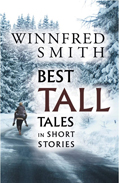
 |
With twenty short stories and three personal nonfiction essays, Smith's book is filled with a diverse array of characters and situations under genres such as action, mystery, romance, magical realism, or a combination of these. Despite the different themes and types throughout, Smith's style of writing is quite evident throughout the collection. He writes with a direct, conversational tone, with the stories relying heavily on dialogue for plot rather than movement. That's not to say that there aren't stories with a bit of action, especially those that follow federal agent narrators.. Either way, the focus on dialogue makes reading these short stories a breeze. At times, Smith also experiments with playful writing—stories that start off directly addressing the reader as if they were in conversation with the narrator. In some of these stories, it comes off as awkward, but in others, it helps fortify the narrator's character through their voice.
Another signature of Smith's writing, in many of the pieces, is the literary convention of the damsel-in-distress. In this device, women characters are saved by male main characters and fall in love with their heroes. However, despite this overused trope, many of Smith's tales stand out in their themes and plot choices. "Shining Knight" is a prime example. Todd, a former firefighter who now works a regular desk day job, ends up walking miles to find help after his car breaks down. On his way, he comes across a woman injured from a car accident and helps her find her way home. Little does he know that the woman he is saving is already dead. In this unique take on a ghost story, it is the dead who save the living, healing Todd from the trauma of failing as a firefighter to save several children in his past.
Other stories from the collection shine brightly too. For instance, in "Clanton's Store," a granddaughter learns the truth about her grandfather (unknown to even her family). It is through the narrator's conversation with her that Smith portrays that things are not always what they seem and also explores the sacrifices of true friendship. Then there is "Uncle Allen and the Doll." At the age of three, Margaret's uncle gives her the family's heirloom: a doll. Only years down the line does she discover its power to grant her every wish. With a dash of magical realism, this story explores the dangers of jealousy in hyperbolic form. In "Dark Meeting," the author spins a brief cautionary fable of karma and greed. After stealing top-grade counterfeit plates by killing a courier, Frank is dealt the same hand by someone he thought he could trust. "A Bed of Roses" deals with the time-honored institution of marriage. When a wife and husband grow apart because of a misunderstanding built out of love for the other, the two must learn to put themselves in each other's shoes to rekindle their feelings. Meanwhile, in "The Yellow Shed," Maggie, upon returning to her childhood home after her mother passes away, faces the trauma of her past when she comes across a letter her mother left for her. In this bittersweet short story, Maggie learns to forgive herself and no longer live in the past.
When the author switches from fiction to nonfiction, none of the power of the narrative is lost. While there are only three of these personal essays in the collection, they possibly are the best pieces out of all the writings. They present a raw portrayal of love, family, and loyalty.